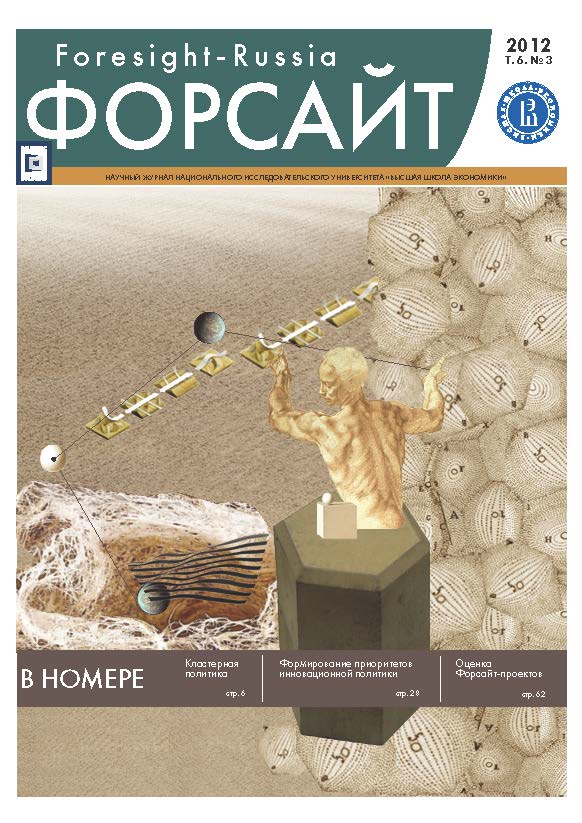Abstract
Debates on the viability—and the extent of public intervention—that are requisite in the formation and development of clusters are ongoing. It seems, on one hand, that there are few cases of systematic and successful cluster creation from the ground up. On another, clusters shaped without any contribution from government are difficult to find. In this sense, the empirical evidence will not readily provide an answer to the questions, how much intervention is needed and are the existing tools adequate for creating clusters.
The author analyses two basic types of market failures related to shaping and development of clusters. These are a mismatch of territorial location of production forces to existing centrifugal and centripetal agglomeration effects (positive and negative external gains, as well as underproduction of a positive external gain that influences performance of local actors.
The paper also concerns possible causes, where public cluster policy produces inefficiencies (government failures). That is, it analyses the most obvious risks for policy implementation. It is argued that an efficient policy should be aimed at dealing with market failures, while the procedures and implementing algorithms — at overcoming government failures.
References
Arthur W. B. (1994) Increasing Returns and Path Dependence in the Economy. Ann Arbor: University of Michigan Press.
Black D., Henderson J.V. (2003). Urban Evolution in the US // Journal of Economic Geography. Vol. 3ю № 4. P. 343-372.
David P.A. (1985) Clio and the Economics of QWERTY // American Economic Review. Vol. 75. № 2. P. 332-337.
Duranton G. (2011) California Dreamin': The Feeble Case for Cluster Policies // Review of Economic Analysis. № 3. P. 3-45.
Duranton G., Puga D. (2001) Nursery Cities // American Economic Review. Vol. 91. P. 1454-1477.
Duranton G., Puga D. (2004) Microfoundations of urban agglomeration economies // Henderson V., Thisse J.-F. (eds.) Handbook of Regional and Urban Economics. Vol. 4. Amsterdam: North Holland. P. 2063-2117.
Henderson V. (2003) Marshall's Scale Economies // Journal of Urban Economy. Vol. 53. P. 1-28.
Henderson V., Kuncoro A., Turner M. (1995) Industrial Development in Cities // Journal of Political Economy. Vol. 103 (5). P. 1067-1090.
Jaruzelski B., Dehoff K. (2007) The Consumer Connection: The Global Innovation 1000 (Strategy+Business Resilience Report). Booz Allen Hamilton. http://www.strategy-business.com/media/file/resilience-12-10-07.pdf (accessed 15 August 2012).
Ketels C. (2003) The Development of the Cluster Concept - Present Experiences and Further Developments. Paper presented at the NRW Conference on Clusters, 5-th December, Duisburg, Germany. http://www.isc.hbs.edu/pdf/Frontiers_of_Cluster_Research_2003.11.23.pdf (accessed 17 July 2012).
Kolko J. (1999) Can I Get Some Service Here? Information Technology, Service Industries, and Future Cities (mimeo). Harvard University.
Margolis S.E., Liebowitz S.J. (1998) Path Dependence // Newman P. (ed.) The New Palgrave Dictionary of Economics and Law. London: Macmillan.
Marshall А. (1920) Principles of Economics (8-th ed). London: Macmillan and Co.
Martin P., Mayer T., Mayneris F. (2008) Spatial concentration and firm-level productivity in France (discussion paper № 6858). CEPR.
Martin P., Mayer T., Mayneris F. (2010) Public Support to Clusters: A Firm Level Study of French Local Productive Systems (mimeo). University of Paris I. http://perso.uclouvain.be/florian.mayneris/rsue.pdf (accessed 31 May 2012).
Menzel M.-P., Fornahl D. (2007) Cluster Life Cycles - Dimensions and Rationales of Cluster Development // Jena Economic Research Papers. http://papers.ssrn.com (accessed 29 June 2012).
Neffke F., Henning S.M., Boschma R., Lundquist K.-J., Olander L.-O. (2008). Who Needs Agglomeration? Varying Agglomeration Externalities and the Industry Life Cycle (Working Paper). Utrecht University.
Porter M. (2000) Location, Competition and Economic Development: Local Clusters in a Global Economy // Economic Development Quarterly. Vol. 14. № 1. P. 15-34.
Richter R., Streb J. (2011) Catching-Up and Falling Behind - Knowledge Spillover from American to German Machine Tool Makers // The Journal of Economic History. Vol. 71. № 4. P. 1006-1031.
Rigby D.L., Essletzbichler A. (2006) Technological variety, technological change and a geography of production techniques // Journal of Economic Geography. № 6. P. 45-70.
Vorobyev P.V., Kislyak N.V., Davidson N.B. (2010) Spatial concentration and firm performance in Russia. Kiev: EERC.
van der Linde C. (2003) The Demography of Clusters - Findings from the Cluster Metastudy // Brцcker J., Dohse D., Soltwedel R. (eds.) Innovation Clusters and Interregional Competition. Berlin: Springer Verlag. P. 130-149.
Абашкин В.Л., Бояров А.Д., Куценко Е.С. (2012) Кластерная политика в России: от теории к практике // Форсайт. Т. 6. № 3. С. 16-27.
Гнедовский М. (2005) Творческие индустрии: политический вызов для России // Отечественные записки. № 4 (24). http://www.strana-oz.ru/?numid=25&article=1106 (дата доступа 15 июня 2012 г.).
Дероше П. (2011) Возможна ли новая Кремниевая долина? Публичная лекция на Полит.ру. http://www.polit.ru/lectures/2011/04/08/deroche.html (дата доступа 25 августа 2012 г.).
Коуз Р. (1993) Проблема социальных издержек // Фирма, рынок и право. М.: Дело ЛТД. С. 87-141.
Кулишер И.М. (2004) История экономического быта Западной Европы. 9-е изд. Т. 1. Челябинск: Социум.
Куценко Е.С. (2012) Зависимость от предшествующего развития в сфере пространственного размещения производительных сил - плохая новость для эмпирических исследований агломерационных эффектов // Журнал Новой экономической ассоциации. № 2 (14). С. 10-26.
Куценко Е.С., Тюменцева Д.С. (2011) Кластеры и инновации в субъектах РФ: результаты эмпирического исследования // Вопросы экономики. № 9. С. 93-107.
Латов Ю.В. (2005) Мы живем не в лучшем из миров! (Популярное изложение QWERTY-номики и исследований Path Dependence) // 20 лет исследования QWERTY-эффектов и зависимости от предшествующего развития. http://ecsocman.edu.ru/text/16213114/ (дата доступа 17 марта 2012 г.).
Райзберг Б.А., Лозовский Л.Ш., Стародубцева Е.Б. (1999) Современный экономический словарь (2-е изд., испр.). М.: ИНФРА-М.
СОПС (2009) Разработка методических рекомендаций по развитию территориальных кластеров в субъектах Российской Федерации. Отчет о научно-исследовательской работе (шифр П315-19-09, № государственной регистрации 01200952406). М.: СОПС.
Скоробогатов А.С. (2006) Институциональная экономика. Курс лекций. СПб.: ГУ-ВШЭ.

This work is licensed under a Creative Commons Attribution 4.0 International License.

